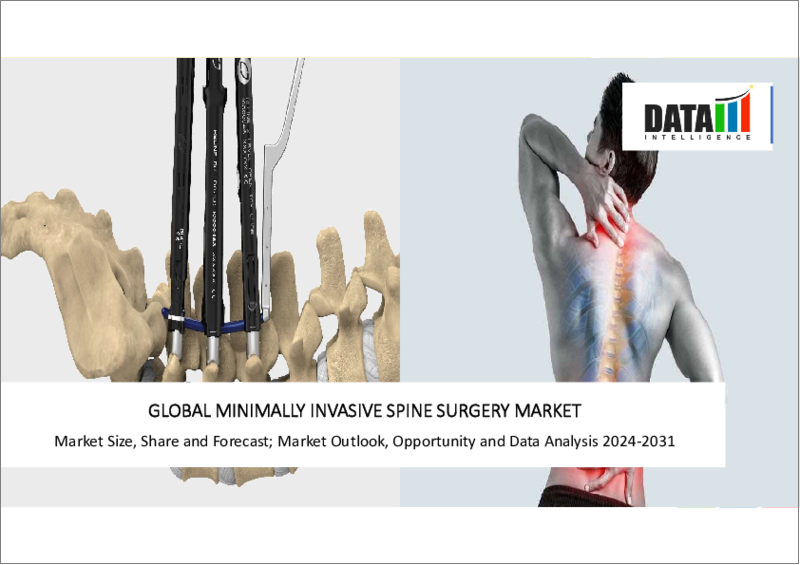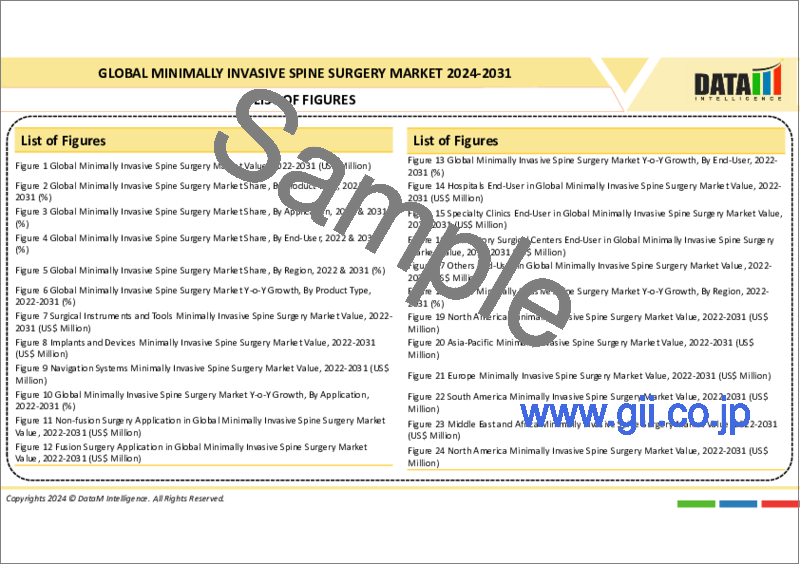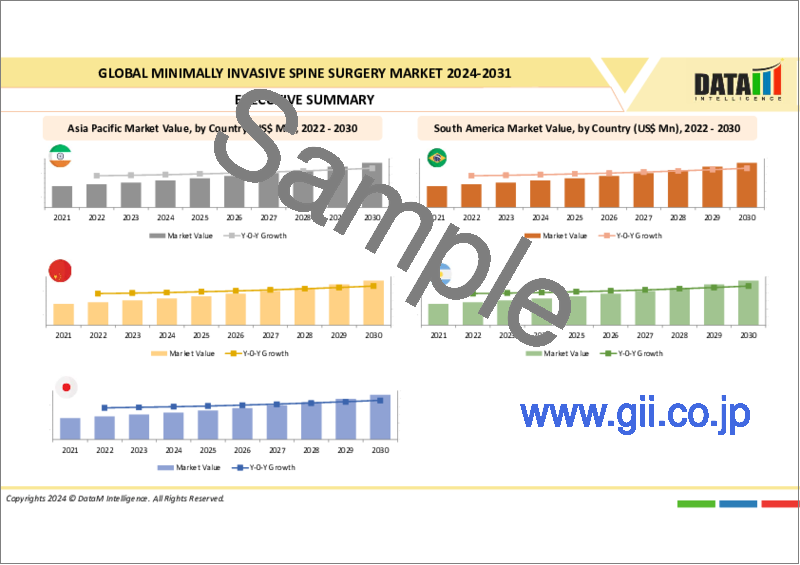|
|
市場調査レポート
商品コード
1285076
低侵襲脊椎手術の世界市場-2023-2030Global Minimally Invasive Spine Surgery Market - 2023-2030 |
||||||
カスタマイズ可能
適宜更新あり
|
|||||||
| 低侵襲脊椎手術の世界市場-2023-2030 |
|
出版日: 2023年06月05日
発行: DataM Intelligence
ページ情報: 英文 195 Pages
納期: 即日から翌営業日
|
- 全表示
- 概要
- 目次
市場概要
低侵襲脊椎手術の世界市場は、2022年に26億7,980万米ドルに達し、2030年には41億6,440万米ドルに達すると予測され、予測期間2023-2030年のCAGRは5.8%と予測されています。低侵襲脊椎手術の市場動向は、新規技術への大規模な投資と研究開発の活発化を示しています。
低侵襲脊椎手術の市場範囲は、インストルメントとデバイスにセグメント化された製品タイプで構成されており、これが低侵襲脊椎手術の市場シェアを高めています。脊椎疾患の有病率の増加や高齢者人口の増加は、低侵襲脊椎手術の需要を促進する機会を創出するでしょう。
低侵襲脊椎手術の世界市場は、低侵襲手術の採用の増加、研究開発の進展、技術的に高度な製品の創出などの要因によって拡大しています。2022年6月、Parkinson's Africa(PA)とAdewunmi Desalu Parkinson's Foundation(ADPF)という2つの非政府組織(NGO)が、ナイジェリアの政府と社会に対して、この症状に対する認識を高めるように働きかけました。
市場力学
低侵襲手術の需要増が低侵襲脊椎手術市場の成長を牽引
低侵襲手術の需要の高まりが、市場の成長を促進しています。低侵襲脊椎手術では、ツールを使用して、比較的小さな切開を通して痛みの原因にトンネルを作ります。低侵襲脊椎手術中または手術後に合併症が発生する可能性は低くなります。このプロセスには、従来の外科手術ほど多くの筋肉の切断や引っ張りは含まれません。
その結果、患者さんは、より良い美容的な結果、出血の減少、より早い回復の恩恵を受けることができます。椎間板ヘルニア、椎間板変性症、脊柱管狭窄症、脊椎すべり症は、すべて低侵襲脊椎手術で治療することができます。この手術が脊椎外科医によって行われれば、患者さんは脊椎外科の訓練を受けた熟練した専門家の手に委ねられることになります。
技術的進歩の高まりと高度な調査により、メーカーにとって有利な機会が生まれます
低侵襲脊椎手術(MISS)は、減圧術の大部分と固定術の約半分に、全体的または部分的に使用することができます。脊椎治療は、最新の画像診断機器や手術機器の開発により、切開回数が少なく、視界が良好で、出血量が少なく、回復が早い低侵襲な手術ができるようになりました。
脊椎手術の発展に伴い、術後の結果や患者の満足度を向上させるために、術前の計画、患者の選択、手術の実行を支援する多くの最先端技術が登場する予定です。これらの技術には、ロボット脊椎手術、機械学習、人工知能が含まれます。
低侵襲手術に関連する欠点が市場の成長を阻害する
しかしながら、低侵襲脊椎手術の世界市場は、様々な要因によって予測期間中に制約を受ける可能性があります。低侵襲手術の主な欠点は、それが比較的新しいということです。新しいだけに、従来の手術のような進歩はありません。低侵襲手術にはより高いレベルのトレーニングが必要であり、経験不足は困難を招く可能性があります。
COVID-19の影響分析
COVID-19分析では、価格ダイナミクス、需給スペクトル、政府の取り組み、メーカーの戦略的取り組みに加えて、COVIDシナリオ前、COVIDシナリオ、COVIDシナリオ後を考慮に入れています。これらの要因により、取引制限、封鎖、後遺症などの問題が発生し、需給が変動する可能性があります。
ロシア・ウクライナ紛争影響分析
ロシア・ウクライナ紛争は、この地域の主要な市場プレイヤーの数が少ないことから、世界の低侵襲脊椎手術市場に与える影響は少ないと推定されます。しかし、原材料の輸出入の影響は、予測期間中、世界の低侵襲脊椎手術市場の成長にほとんど影響を与えないと予想されます。
目次
第1章 調査手法とスコープ
- 調査手法
- 調査目的および調査範囲
第2章 定義と概要
第3章 エグゼクティブサマリー
第4章 市場力学
- 影響要因
- 促進要因
- 低侵襲手術の需要の高まり
- 技術的進歩の高まりと高い研究成果
- 抑制要因
- 低侵襲手術に関連する欠点
- 機会
- 病気にかかりやすい老人と肥満の人口の増加
- 影響分析
- 促進要因
第5章 産業分析
- ポーターの5フォース分析
- サプライチェーン分析
- 価格分析
- 法規制の分析
第6章 COVID-19の分析
- COVID-19の分析
- COVID前のシナリオ
- COVID中のシナリオ
- COVID後のシナリオ
- COVID-19の中での価格・ダイナミクス
- 需給スペクトル
- パンデミック時の市場に関連する政府の取り組み
- メーカーの戦略的な取り組み
- サマリー
第7章 製品タイプ別
- インストゥルメンテーション
- 機器
第8章 アプリケーション別
- 非融合手術
- 融合手術
- 椎間板変性症
- 椎間板ヘルニア
- 腰部脊柱管狭窄症
- 脊柱変形(脊柱管狭窄症)
- 脊椎の感染症
- 脊椎不安定症(脊椎すべり症)
- 椎体圧迫骨折
- 脊椎腫瘍
第9章 エンドユーザー別
- 病院
- 外来手術センター
- その他
第10章 地域別
- 北米
- 米国
- カナダ
- メキシコ
- 欧州
- ドイツ
- 英国
- フランス
- イタリア
- スペイン
- その他欧州
- 南米
- ブラジル
- アルゼンチン
- その他南米地域
- アジア太平洋地域
- 中国
- インド
- 日本
- その他アジア太平洋地域
- 中東・アフリカ地域
- 地域別の主なダイナミクス
第11章 競合情勢
- 競合シナリオ
- 市況ポジショニング/シェア分析
- M&A(合併・買収)分析
第12章 企業プロファイル
- Zimmer Biomet
- 会社概要
- 製品ポートフォリオと説明
- 財務概要
- 主な発展状況
- DePuy Synthes(Johnson & Johnson)
- Stryker
- Medtronic
- Aesculap, Inc.(B. Braun Company)
- Alliance Spine
- NuVasive Inc.
- Bioventus
- Integra LifeSciences
- Globus Medical
第13章 付録
Market Overview
The global minimally invasive spine surgery market reached US$ 2,679.8 million in 2022 and is expected to reach US$ 4,164.4 million by 2030 and is expected to grow with a CAGR of 5.8% during the forecast period 2023-2030. The minimally invasive spine surgery market trends show large investments in novel technologies and increasing research and development.
The minimally invasive spine surgery market scope comprises product type segmented as instrumentation and devices, which has increased the market share for minimally invasive spine surgery. The increasing prevalence of spinal disorders and the growing older population will create opportunities to drive the demand for minimally invasive spine surgery.
The global market for minimally invasive spine surgery is expanding as a result of factors including the increasing adoption of minimally invasive procedures, the growing research and development, and the creation of technologically advanced products. In June 2022, Parkinson's Africa (PA) and Adewunmi Desalu Parkinson's Foundation (ADPF), two non-governmental organizations (NGOs), have encouraged the government and society in Nigeria to raise awareness of the condition.
Market Dynamics
The Rise in the Demand for Minimally Invasive Surgeries Drives The Growth Of The Minimally Invasive Spine Surgery Market.
The rising demand for minimally invasive surgical procedures is driving the market's growth. In minimally invasive spine surgery, a tool is used to tunnel to the pain's source through a relatively small incision. Complications are less likely to occur during or following minimally invasive spine surgery. The process does not include as much muscle cutting or tugging as conventional surgical techniques.
As a result, the patient will benefit from better cosmetic outcomes, reduced blood loss, and a quicker recovery. Herniated discs, degenerative disc disease, spinal stenosis, and spondylolisthesis can all be treated with minimally invasive spine surgery. The patient will be in the hands of a skilled expert trained in spine surgery if this procedure is carried out by a spine surgeon.
Rising Technological Advancements and High Research Creates Lucrative Opportunities For Manufacturers.
Minimally invasive spine surgery (MISS) procedures can be used wholly or partially for the majority of decompressions and about half of the fusions. Spine treatments can now be performed minimally invasively with fewer incisions, better vision, less blood loss, and a quicker recovery thanks to the development of modern imaging and surgical equipment.
With the development of spine surgery, a number of cutting-edge technologies are on the horizon to help with pre-operative planning, patient selection and surgical execution in order to guarantee improved post-operative results and patient satisfaction. These technologies include robotic spine surgery, machine learning and artificial intelligence.
Drawbacks Associated with Minimally Invasive Surgeries Will Hamper The Growth Of The Market.
The global marketplace for minimally invasive spine surgery, however, may be constrained over the projected period due to various factors. The primary drawback of minimally invasive surgery is that it is relatively new. There haven't been as many advancements as with conventional surgery because it's newer. A higher level of training is necessary for minimally invasive surgery, and lack of experience can result in difficulties.
COVID-19 Impact Analysis
The COVID-19 analysis takes into account the Pre-COVID Scenario, COVID Scenario, and Post-COVID Scenario in addition to pricing dynamics, demand-supply spectrum, government initiatives, and manufacturers strategic initiatives. These factors could cause supply and demand to shift as a result of trading restrictions, lockdowns, and after-effects issues.
Russia-Ukraine War Impact Analysis
The Russia-Ukraine conflict is estimated to have a low impact on the global minimally invasive spine surgery market, owing to the low number of key market players in this region. However, the impact of the import and export of raw materials is expected to have little influence over the global minimally invasive spine surgery market growth over the forecast period.
Segment Analysis
The global minimally invasive spine surgery market is segmented based on product type, application, end user and region.
Fusion Surgery from Application Segment Accounts For 62.8% Of Market Share Owing To Rising Adoption.
Spinal fusion involves a surgical procedure that permanently fuses two or more vertebrae in the spine. In comparison to conventional spinal fusion surgery, minimally invasive spinal fusion employs a smaller cut (incision). A smaller incision is required for minimally invasive spinal fusion than for conventional surgery. Additionally, the muscle tissues of the spine are not taken away.
This could result in quicker recovery times than with standard surgery. It might also lessen the likelihood of some issues. Different methods may be used by the surgeon to access the vertebrae. For instance, the surgeon approaches the vertebrae from the side when doing direct lateral interbody fusion. In lumbar interbody fusion, the spine is approached from the back by the surgeon.
Geographical Analysis
North America Accounted For Approximately 44.1% Of The Market Share Owing To The Strong Presence Of Major Players And Increasing Technological Advancements.
Manufacturers have chances to expand their operations in this region because of the rising demand for minimally invasive spine surgery for advancements in North America. The area has many producers and suppliers, and its rapid economic development has raised industrial production of novel products and technologies for minimally invasive surgeries, which has increased the demand.
North America has a large number of producers and suppliers, and as a result of the swift economic development of the area, industrial production has increased, fueling the demand of minimally invasive spine surgery. Rising new product launches for using in patients with spinal disorders will drive the market growth. Growth is also fueled by the rising technological advancements, regulatory approvals and novel product launches. These factors shows the dominance of North America.
Competitive Landscape
The major global players in the minimally invasive spine surgery market include: Zimmer Biomet, Stryker, DePuy Synthes (Johnson & Johnson), Medtronic, Alliance Spine, Aesculap, Inc. (B. Braun Company), Bioventus, NuVasive Inc., Integra LifeSciences, and Globus Medical among others.
Why Purchase the Report?
- To visualize the global minimally invasive spine surgery market segmentation based on product type, application, end user and region, as well as understand key commercial assets and players.
- Identify commercial opportunities by analyzing trends and co-development.
- Excel data sheet with numerous data points of minimally invasive spine surgery market-level with all segments.
- PDF report consists of a comprehensive analysis after exhaustive qualitative interviews and an in-depth study.
- Product mapping available as Excel consisting of key products of all the major players.
The global minimally invasive spine surgery market report would provide approximately 53 tables, 54 figures and 195 Pages.
Target Audience 2023
- Manufacturers/ Buyers
- Industry Investors/Investment Bankers
- Research Professionals
- Emerging Companies
Table of Contents
1. Methodology and Scope
- 1.1. Research Methodology
- 1.2. Research Objective and Scope of the Report
2. Definition and Overview
3. Executive Summary
- 3.1. Snippet by Product Type
- 3.2. Snippet by Application
- 3.3. Snippet by End User
- 3.4. Snippet by Region
4. Dynamics
- 4.1. Impacting Factors
- 4.1.1. Drivers
- 4.1.1.1. The Rise in the Demand for Minimally Invasive Surgeries
- 4.1.1.2. Rising Technological Advancements and High Research
- 4.1.2. Restraints
- 4.1.2.1. Drawbacks Associated with Minimally Invasive Surgeries
- 4.1.3. Opportunity
- 4.1.3.1. The Growth in the Geriatric and Obese Population Susceptible to Diseases
- 4.1.4. Impact Analysis
- 4.1.1. Drivers
5. Industry Analysis
- 5.1. Porter's 5 Force Analysis
- 5.2. Supply Chain Analysis
- 5.3. Pricing Analysis
- 5.4. Regulatory Analysis
6. COVID-19 Analysis
- 6.1. Analysis of COVID-19
- 6.1.1. Scenario Before COVID
- 6.1.2. Scenario During COVID
- 6.1.3. Scenario Post COVID
- 6.2. Pricing Dynamics Amid COVID-19
- 6.3. Demand-Supply Spectrum
- 6.4. Government Initiatives Related to the Market During Pandemic
- 6.5. Manufacturers Strategic Initiatives
- 6.6. Conclusion
7. By Product Type
- 7.1. Introduction
- 7.1.1. Market Size Analysis and Y-o-Y Growth Analysis (%), By Product Type
- 7.1.2. Market Attractiveness Index, By Product Type
- 7.2. Instrumentation *
- 7.2.1. Introduction
- 7.2.2. Market Size Analysis and Y-o-Y Growth Analysis (%)
- 7.3. Devices
8. By Application
- 8.1. Introduction
- 8.1.1. Market Size Analysis and Y-o-Y Growth Analysis (%), By Application
- 8.1.2. Market Attractiveness Index, By Application
- 8.2. Non-fusion Surgery *
- 8.2.1. Introduction
- 8.2.2. Market Size Analysis and Y-o-Y Growth Analysis (%)
- 8.3. Fusion Surgery
- 8.3.1. Degenerative disc disease
- 8.3.2. Herniated disc
- 8.3.3. Lumbar spinal stenosis
- 8.3.4. Spinal deformities (scoliosis)
- 8.3.5. Spinal infections
- 8.3.6. Spinal instability (spondylolisthesis)
- 8.3.7. Vertebral compression fractures
- 8.3.8. Spinal tumors
9. By End User
- 9.1. Introduction
- 9.1.1. Market Size Analysis and Y-o-Y Growth Analysis (%), By End User
- 9.1.2. Market Attractiveness Index, By End User
- 9.2. Hospitals *
- 9.2.1. Introduction
- 9.2.2. Market Size Analysis and Y-o-Y Growth Analysis (%)
- 9.3. Ambulatory Surgical Centers
- 9.4. Others
10. By Region
- 10.1. Introduction
- 10.1.1. Market Size Analysis and Y-o-Y Growth Analysis (%), By Region
- 10.1.2. Market Attractiveness Index, By Region
- 10.2. North America
- 10.2.1. Introduction
- 10.2.2. Key Region-Specific Dynamics
- 10.2.3. Market Size Analysis and Y-o-Y Growth Analysis (%), By Product Type
- 10.2.4. Market Size Analysis and Y-o-Y Growth Analysis (%), By Application
- 10.2.5. Market Size Analysis and Y-o-Y Growth Analysis (%), By End User
- 10.2.6. Market Size Analysis and Y-o-Y Growth Analysis (%), By Country
- 10.2.6.1. The U.S.
- 10.2.6.2. Canada
- 10.2.6.3. Mexico
- 10.3. Europe
- 10.3.1. Introduction
- 10.3.2. Key Region-Specific Dynamics
- 10.3.3. Market Size Analysis and Y-o-Y Growth Analysis (%), By Product Type
- 10.3.4. Market Size Analysis and Y-o-Y Growth Analysis (%), By Application
- 10.3.5. Market Size Analysis and Y-o-Y Growth Analysis (%), By End User
- 10.3.6. Market Size Analysis and Y-o-Y Growth Analysis (%), By Country
- 10.3.6.1. Germany
- 10.3.6.2. The U.K.
- 10.3.6.3. France
- 10.3.6.4. Italy
- 10.3.6.5. Spain
- 10.3.6.6. Rest of Europe
- 10.4. South America
- 10.4.1. Introduction
- 10.4.2. Key Region-Specific Dynamics
- 10.4.3. Market Size Analysis and Y-o-Y Growth Analysis (%), By Product Type
- 10.4.4. Market Size Analysis and Y-o-Y Growth Analysis (%), By Application
- 10.4.5. Market Size Analysis and Y-o-Y Growth Analysis (%), By End User
- 10.4.6. Market Size Analysis and Y-o-Y Growth Analysis (%), By Country
- 10.4.6.1. Brazil
- 10.4.6.2. Argentina
- 10.4.6.3. Rest of South America
- 10.5. Asia-Pacific
- 10.5.1. Introduction
- 10.5.2. Key Region-Specific Dynamics
- 10.5.3. Market Size Analysis and Y-o-Y Growth Analysis (%), By Product Type
- 10.5.4. Market Size Analysis and Y-o-Y Growth Analysis (%), By Application
- 10.5.5. Market Size Analysis and Y-o-Y Growth Analysis (%), By End User
- 10.5.6. Market Size Analysis and Y-o-Y Growth Analysis (%), By Country
- 10.5.6.1. China
- 10.5.6.2. India
- 10.5.6.3. Japan
Australia
- 10.5.6.4. Rest of Asia-Pacific
- 10.6. Middle East and Africa
- 10.6.1. Introduction
- 10.6.2. Key Region-Specific Dynamics
- 10.6.3. Market Size Analysis and Y-o-Y Growth Analysis (%), By Product Type
- 10.6.4. Market Size Analysis and Y-o-Y Growth Analysis (%), By Application
- 10.6.5. Market Size Analysis and Y-o-Y Growth Analysis (%), By End User
11. Competitive Landscape
- 11.1. Competitive Scenario
- 11.2. Market Positioning/Share Analysis
- 11.3. Mergers and Acquisitions Analysis
12. Company Profiles
- 12.1. Zimmer Biomet *
- 12.1.1. Company Overview
- 12.1.2. Product Portfolio and Description
- 12.1.3. Financial Overview
- 12.1.4. Key Developments
- 12.2. DePuy Synthes (Johnson & Johnson)
- 12.3. Stryker
- 12.4. Medtronic
- 12.5. Aesculap, Inc. (B. Braun Company)
- 12.6. Alliance Spine
- 12.7. NuVasive Inc.
- 12.8. Bioventus
- 12.9. Integra LifeSciences
- 12.10. Globus Medical
LIST NOT EXHAUSTIVE
13. Appendix
- 13.1. About Us and Services
- 13.2. Contact Us






